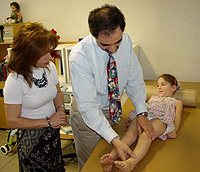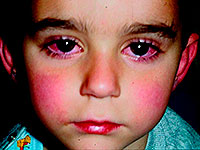It is known that the first year of the baby is a decisive in many ways. It is at this time that the correctness of the formation of many systems of the body is determined, including the bone system. One of the most common orthopedic problems of the newborn is a displasion of hip joints.
Content
Talk about this pathology and answer questions that are most often worried about young parents, we asked the orthopedic surgeon Valery Alpathov, the doctor of the highest category of clinics «Mother and child».
Question number 1. Many mothers, having learned that in the first year of life, the child must be observed from the orthopedic, perplexed: why, if the crumbs seem to be all right?
Diseases of the musculoskeletal system in children of the first months of life a lot. Most often there is a displays of hip joints, which will be discussed. Several degrees of severity of this pathology, the extreme of which is dislocated hip joint. The danger of this state is that it is a hidden congenital pathology, t.E. Specialist can only recognize it.
Therefore, there are often cases when the diagnosis is made too late and a precious time that could be used for treatment, missed. Unfortunately, such situations always turn around for a child with serious consequences, primarily associated with rich violations of motor development and, of course, gait.
Question # 2. What are the causes of displays of hip joints?
 The dysplasia of the hip joints occurs as a result of the improper development of the components of the elements of the hip joint - the bone-cartilage base, the binder capsule or muscle apparatuses of the joint - in the intrauterine period.
The dysplasia of the hip joints occurs as a result of the improper development of the components of the elements of the hip joint - the bone-cartilage base, the binder capsule or muscle apparatuses of the joint - in the intrauterine period.
In girls, this pathology is 4-7 times more often than that of boys. And 10 times more often congenital dislocation of the hips is observed in children born in a butt-cut.
The reason for dysplasia is the delay in the development of a normal hip joint during the intrauterine life of the fetus due to heredity, «Elder» age of parents, infectious diseases of the mother during pregnancy, endocrine pathologies, toxicosis (especially the first half of pregnancy) butorous prevention of the fetus.
The development of dysplasia also affects the poor ecological situation, harmful working conditions, unbalanced nutrition of the future mother, lack of vitamins and minerals that contribute to the proper formation of connecting tissue and mineralization of cartilage tissue.
Question number 3. When the child check the presence of symptoms of dysplasia and what they are?
Diagnose in a newborn, this disease doctors neonatologists start in the maternity hospital In addition, in 1, 3, 6 months and 1 year, the baby must examine the orthopedist.
To suspect the baby, removing you, paying attention to the following symptoms:
- When trying to take a hip, the child begins to cry;
- Appears symptom «Click» or scaling (when the legs are administered in different directions, a dislocation is refused, which is accompanied by a liquecular hand);
- asymmetry of the berry fold (on the dysplasia side, the berry fold; deeper and somewhat higher);
- shortening legs;
- Often when dysplasia is detected by turning the foot of the bed.
These symptoms can manifest themselves together or separately. In their identification, the doctor recommends ultrasound diagnostics. Also, radiography is used to diagnose dysplasia, which allows you to more accurately determine the degree of the disease.
Question number 4. How to treat this pathology?
With a less pronounced degree of disease, treatment may be limited to wide swaddling. In more severe cases, strut tires and other special devices are used - right up to dryness.
Question number 5. How can you protect the newborn baby from the development of dysplasia?
Orthopedian must regularly monitor the physical indicators of your child's development. Dates intended for visiting this specialist are not randomly identified: each of them is associated with certain milestones in the life of the baby.
With timely diagnosis and adequate treatment until 3 months of age, the joint function is almost completely restored. Thus, it is necessary to emphasize once again that early diagnosis is crucial for successful treatment.









